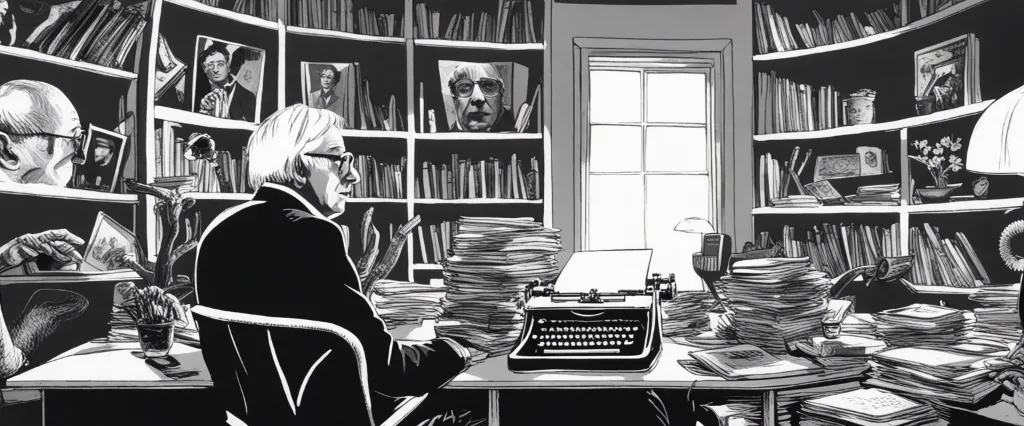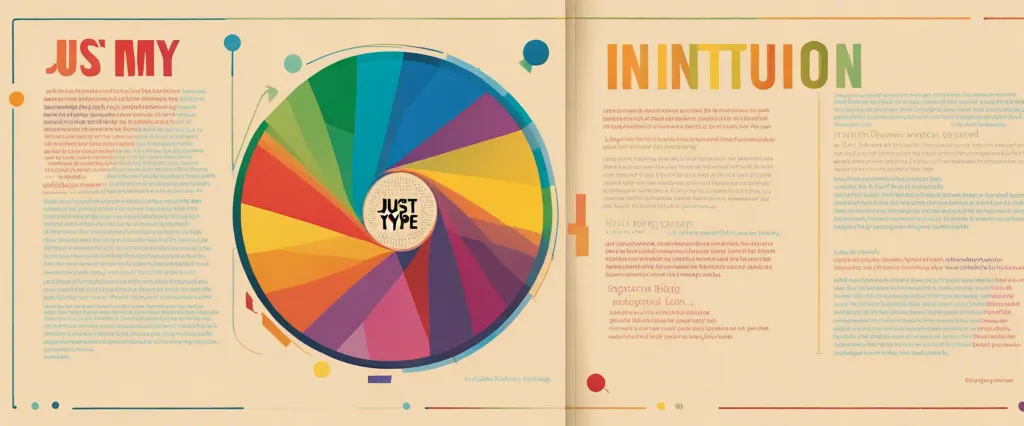In the captivating book “Just My Type“, Simon Garfield delves into the fascinating world of typography, exploring the profound impact it has on our daily lives and culture. With extensive research and a touch of humor, Garfield uncovers the stories behind some of the most iconic fonts, shedding light on the often overlooked art form of type design. As a highly acclaimed British author and journalist, Simon Garfield has written numerous bestselling books, including “On the Map” and “Mauve”. Possessing a passion for the obscure and the overlooked, Garfield’s expertise and engaging storytelling style make “Just My Type” an enjoyable and enlightening journey through the world of fonts.
Chapter 1: The Origins of Typography: Tracing the Evolution of Typography from Ancient Times to the Digital Age
Chapter 1 of “Just My Type” by Simon Garfield, titled “The Origins of Typography: Tracing the Evolution of Typography from Ancient Times to the Digital Age,” explores the rich history and evolution of typography from its earliest beginnings to the modern digital era.
The chapter begins by delving into the origins of typography in Ancient Greece, where the first known typographic artifacts appeared around 800 BCE with the creation of the Phoenician alphabet. It describes how the Greeks developed their own version of the alphabet, which became the foundation for many modern alphabets used today.
Garfield then guides readers through various significant milestones in the evolution of typography, citing notable contributions from cultures such as the Romans, Chinese, and Arabs. He discusses the invention of paper and the development of moveable type, marking a significant shift from laborious handwritten manuscripts to the mass production of printed materials.
The chapter also delves into the Renaissance period, highlighting the groundbreaking work of Johannes Gutenberg and his invention of the printing press around 1450. This invention revolutionized the world of typography, making it more accessible and contributing to the dissemination of knowledge and ideas on an unprecedented scale.
Garfield further explores the influence of different typefaces and fonts throughout history. He explains how typographical innovations like William Caslon’s serif typeface in the 18th century or the sans-serif fonts introduced by Louis-François Rondelet in the 19th century have left a lasting impact on typography and graphic design.
Finally, the chapter concludes by addressing the progression of typography into the digital age. It discusses the emergence of digital fonts and the evolution of new design technologies that have transformed the landscape of typography, making it accessible to anyone with a computer and software.
In essence, Garfield’s first chapter serves as an insightful overview of the origins and development of typography, highlighting its vital role in human history and civilization.
Chapter 2: Typeface Classification: Exploring Different Typeface Categories and Their Characteristics
Chapter 2 of “Just My Type” by Simon Garfield delves into the topic of typeface classification, exploring the different categories and their defining characteristics. This chapter serves as an introduction to the world of typefaces, allowing readers to understand the vast array of fonts available and their significance.
Garfield starts by explaining that typefaces can be broadly classified into serif and sans-serif categories. Serif fonts are characterized by small decorative strokes attached to the ends of letters, while sans-serif fonts lack these adornments, resulting in a clean and minimalist appearance. The author highlights the historical evolution of both categories, from ancient Roman serif fonts to the modern sans-serif revival in the 20th century.
Further, Garfield introduces various subcategories within these two main classifications, including Old Style, Transitional, Modern, Humanist, Geometric, and Grotesque. He explains the unique features and origins of each, such as Old Style typefaces resembling calligraphy and Transitional typefaces blending traditional and modern aspects.
The chapter also explores the influence of technology on typeface design. The development of different printing methods and the transition to digital typography have greatly impacted typeface styles, leading to the creation of new categories like pixel fonts and script fonts.
Throughout the chapter, Garfield provides examples and anecdotes, showcasing the diversity and versatility of typefaces while proving that their classification is not rigid. He emphasizes that typefaces are as much a reflection of their time and purpose as they are an artistic form.
In summary, Chapter 2 of “Just My Type” familiarizes readers with the classification and characteristics of different typeface categories, shedding light on their historical development, technological influence, and unique attributes. The chapter lays the groundwork for deeper exploration into typeface design and appreciation in subsequent chapters of the book.
Chapter 3: Famous Typefaces: Examining Iconic Typefaces and Their Influence on Design and Communication
Chapter 3 of “Just My Type” by Simon Garfield delves into the world of famous typefaces, exploring their impact on design and communication. The chapter presents a variety of iconic typefaces and discusses their history, designers, and the influence they have had on various industries.
Garfield begins by introducing the typeface Helvetica, arguably the most influential and recognizable typeface of all time. He explores its origins in Switzerland and its subsequent rise to global popularity, becoming synonymous with modernity and corporate identity. The chapter discusses how Helvetica sparked both admiration and criticism and how it continues to be widely used in different contexts.
Moving on, Garfield discusses Futura, a typeface known for its geometric shapes and clean lines. Developed in the 1920s, it quickly gained recognition for its modern and futuristic aesthetic, finding its way into numerous science fiction movies and advertisements. Garfield explores how Futura’s unique design influenced art, fashion, and popular culture.
The chapter also dives into other famous typefaces such as Times New Roman, Gill Sans, and Baskerville, each with their own unique stories and design philosophies. Garfield presents the impact these typefaces had, ranging from their influence in print media to shaping brand identities and even significant historical events.
Garfield also discusses the influence of typeface in political campaigns, with examples from the 2008 American presidential election. He explains how the choice of typefaces can evoke specific emotions and convey messages effectively.
Overall, Chapter 3 of “Just My Type” provides an insightful exploration into iconic typefaces and their impact on design and communication. It highlights how typefaces have become integral to our visual culture, shaping our perception of brands, ideas, and even historical moments.
Chapter 4: Typography in Advertising: Analyzing the Role of Typography in Advertising and Branding

Chapter 4 of “Just My Type” by Simon Garfield explores the significance of typography in advertising and branding. The chapter emphasizes the ways in which typography plays a crucial role in shaping consumer perceptions and preferences.
Garfield begins by examining the history of typography in advertising, highlighting examples of iconic campaigns that revolutionized the field. The chapter delves into the impact of different typefaces, letterforms, and layouts on the effectiveness of advertisements. It explains how typography can evoke emotions and create specific associations, helping to establish brand recognition and convey brand values.
The author further explores the relationship between typography and consumer psychology. He explains how certain fonts are perceived as more trustworthy, professional, or trendy, and how advertisers strategically utilize these associations to connect with their target audience. Garfield also discusses the use of typography to reflect cultural trends and values, as well as the importance of legibility and readability in advertising.
Moreover, the chapter delves into the technique of subliminal messaging through typography. It reveals how advertisers subtly manipulate consumers by using certain fonts or letterforms to convey hidden messages or appeal to their subconscious desires.
Throughout the chapter, “Just My Type” provides numerous examples and case studies to illustrate the impact of typography in advertising. These include renowned campaigns such as Coca-Cola, Volkswagen, and Apple, which successfully utilize typography to establish and maintain their brand identities.
In summary, Chapter 4 of “Just My Type” offers a comprehensive analysis of the role of typography in advertising and branding. It showcases how typography influences consumer perceptions, creates brand recognition, and conveys hidden messages, all of which ultimately contribute to the success of advertising campaigns.
Chapter 5: Typography in Print: Exploring the Importance of Typography in Books, Magazines, and Newspapers
Chapter 5 of “Just My Type” by Simon Garfield focuses on the significance of typography in print media, namely books, magazines, and newspapers. Typography, the art and technique of arranging type, plays a crucial role in enhancing the reading experience and conveying information effectively.
Garfield begins the chapter by highlighting the historical evolution of book typography. He explains the transition from handwritten manuscripts to printed books and the development of various typefaces. Gutenberg’s invention of movable type revolutionized the printing industry, allowing for mass production and the proliferation of books. Different fonts and typographic styles emerged over time, influencing the overall aesthetic and readability of printed material.
The author emphasizes the importance of selecting appropriate typefaces that enhance content comprehension and emotional engagement. Different genres benefit from varying typographic approaches: for instance, serif typefaces tend to be favored in novels and long-form content, while sans-serif fonts are often utilized in newspapers and magazines for their legibility.
Furthermore, Garfield explores the role of designers and typographers in creating visually striking book covers. Typeface selection, spacing, and color combinations all contribute to making a book stand out on shelves and attract potential readers.
The chapter delves into the realm of magazines, where typography plays a vital role in creating layouts that capture readers’ attention. The use of hierarchy, different font weights, and sizes helps guide readers’ eyes and emphasize key information. Additionally, magazines often experiment with innovative typographic treatments to create visually arresting designs.
Lastly, Garfield discusses the importance of type in newspapers. Typography is crucial for creating clarity and organizing information in news articles, while headline typography must grab readers’ attention amidst numerous distractions. Journalists and editors collaborate closely with designers to ensure that typography complements the news content effectively.
In conclusion, Chapter 5 emphasizes the immense significance of typography in print media. Typeface selection, design, and layout choices impact both the aesthetic appeal and readability of books, magazines, and newspapers, ultimately enhancing the overall reading experience for audiences.
Chapter 6: The Digital Revolution: Investigating the Impact of Digital Technology on Typography and Design
Chapter 6 of “Just My Type” by Simon Garfield delves into the transformative effects of digital technology on typography and design in the modern era. This chapter explores how the digital revolution has revolutionized the way typefaces are created, consumed, and distributed.
Garfield discusses the advent of desktop publishing in the late 1980s, which democratized typography by placing the tools of professional typesetting within reach of ordinary individuals. He highlights the significance of Apple’s Macintosh computer and how it brought graphic design capabilities to the masses. As a result, typography underwent a seismic shift, with designers having access to an array of digital fonts and the ability to manipulate them with ease.
The chapter explores the transition from analog to digital type, emphasizing the challenges faced by traditional type foundries. With the rise of digital fonts and licensing issues, many traditional foundries confronted piracy concerns. However, this also opened up new possibilities for collaboration and innovation within the typography community.
Garfield also delves into the impact of the internet on typography and design. He discusses the birth of the World Wide Web and how it presented new opportunities and constraints for designers. The rise of web fonts led to the improvement of online typography. Yet, the internet also brought challenges with the proliferation of poorly designed websites and the decline of print media.
Furthermore, the chapter touches upon the influence of social media platforms, such as Twitter and Instagram, on typography. Garfield examines the role of typography in conveying emotions, eliciting engagement, and creating memorable branding in these digital spaces. He reveals how digital platforms have transformed the visibility and accessibility of typography, making it an integral part of our daily lives.
Overall, Chapter 6 illuminates the profound impact of the digital revolution on typography and design, from the democratization of tools and fonts to the challenges and opportunities brought about by the internet and social media. It encapsulates the shift from traditional print media to the digital landscape, highlighting the ever-evolving nature of typography in the modern era.
Chapter 7: The Art of Kerning and Letter-spacing: Understanding the Importance of Proper Spacing in Typography
Chapter 7 of “Just My Type” by Simon Garfield delves into the significance of kerning and letter-spacing in typography. Garfield begins by discussing the history of kerning and the challenges it posed in typesetting. Kerning refers to adjusting the space between specific pairs of letters to ensure visually pleasing and harmonious text. The author emphasizes that proper kerning can drastically impact the legibility, aesthetics, and overall tone of a text.
Garfield explores the role of technology, particularly computer fonts, in revolutionizing the world of kerning. He highlights the standardization of kerning pairs, where typographers meticulously determine the appropriate spacing between each letter combination. However, he also notes the limitations of this approach, as it neglects the unique characteristics of individual letters.
The author explores the impact of poor kerning on public signage and corporate logos. He provides numerous examples of kerning disasters, like the notorious “Village Expert” sign where the spacing between “V” and “I” unintentionally forms a vulgar word. Garfield argues that such mistakes can harm a brand’s image and credibility.
Furthermore, this chapter touches upon the emergence of “kerning crimes” and the rise of public interest in typography. The author highlights how passionate typographers and designers study and critique kerning in contemporary culture, often exposing flawed letter-spacing in advertisements and logos.
Garfield concludes by stressing the importance of proper kerning in maintaining the integrity of a message or brand. He asserts that kerning requires attention to detail, expertise, and an understanding of the impact of letter-spacing on the reader’s perception.
In summary, Chapter 7 of “Just My Type” explores the historical significance and contemporary relevance of kerning. Garfield emphasizes how proper kerning can greatly enhance typographic legibility, aesthetics, and overall communication. He also highlights the consequences of poor kerning on brands and public perception.

Chapter 8: Typography in Everyday Life: Discovering the Ubiquity of Typography in Signs, Packaging, and Public Spaces
Chapter 8 of “Just My Type” by Simon Garfield explores the role of typography in everyday life, particularly in signs, packaging, and public spaces. The author discusses how typography serves as a means of communication, conveying messages and influencing our perception of products and environments.
Garfield begins by highlighting the ubiquity of typography, emphasizing how it surrounds us in our daily lives, from street signs to food packaging. He explains that typography plays a vital role in conveying information quickly and effectively, enabling us to navigate and interact with our surroundings.
The chapter delves into the history and development of signage, starting with the early handwritten signs and progressing to the introduction of neon signs and digital displays. Garfield discusses the significance of font choices in sign design and the need for legibility, readability, and clarity to ensure effective communication.
Packaging typography is also explored, with the author examining the evolution of product labeling and the use of typography to capture consumer attention and communicate brand values. He discusses the impact of packaging on consumer decision-making and the influence of different font styles, sizes, and colors on purchasing behavior.
Furthermore, Garfield explores how typography shapes our experience of public spaces. He highlights iconic examples of typography in architecture, such as the Hollywood sign, and discusses the use of fonts on street signs and in public transportation systems.
Overall, Chapter 8 of “Just My Type” emphasizes the influential role of typography in our everyday lives, illustrating how it guides and informs us in various settings. Typography serves as a powerful tool for communication, branding, and creating memorable experiences, making it an essential aspect of design and visual culture.
After Reading
In conclusion, Simon Garfield’s book, “Just My Type,” reveals the fascinating world hidden behind the seemingly plain objects that surround us daily – fonts. Through captivating anecdotes and meticulous research, Garfield delves into the history, artistry, and impact of typefaces, as well as their significant role in shaping culture and communication. From the birth of Gutenberg’s movable type to the modern era of digital fonts, Garfield demonstrates that fonts are not merely utilitarian tools, but powerful instruments that can evoke emotions, convey messages, and even shape our perception. “Just My Type” is an illuminating exploration that will forever change the way readers view the typography that surrounds them.
1. “The Elements of Typographic Style” by Robert Bringhurst – Like “Just My Type,” this book delves into the world of typography and explores the art and science behind it. It provides an in-depth exploration of typographic principles and showcases various examples of typefaces in a visually engaging manner.
2. “Thinking with Type: A Critical Guide for Designers, Writers, Editors, & Students” by Ellen Lupton – This book is a must-read for anyone interested in typography and its practical applications. It covers the history, anatomy, and language of type, and offers valuable insights into how typography can enhance communication and design.
3. “The Anatomy of Type: A Graphic Guide to 100 Typefaces” by Stephen Coles – Similar to “Just My Type,” this book delves into the history and characteristics of numerous typefaces. It offers a comprehensive visual guide to 100 popular typefaces, accompanied by concise descriptions and analyses, making it a valuable resource for designers and typophiles alike.
4. “100 Ideas that Changed Graphic Design” by Steven Heller and Véronique Vienne – While not solely focused on typography, this book explores various design movements, techniques, and ideas that have shaped the graphic design landscape. It includes sections dedicated to the evolution and impact of typography, making it a relevant and fascinating read for fans of “Just My Type.”
5. “The Typeface Compendium: A Critical Guide to the World’s Best Typefaces” by Ben Archer – This book provides a comprehensive overview of noteworthy typefaces from around the world. It features detailed descriptions, samples, and historical context for each featured typeface, making it a valuable resource for designers and anyone interested in the art of typography.




